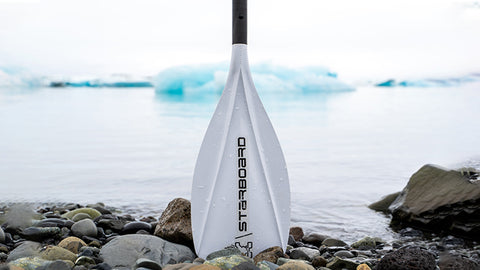The paddle is the most important part of the paddle, next to paddle technology. Imagine sitting in a new car that doesn't have power steering. That's how it is with oars. The entire supercar experience depends on their technology and manufacturing quality. Although all oars look similar at first glance, they are much more complex. You will find differences in the shovel, construction, strength, weight and price. So what do you need to know when buying a sup paddle?
How is the oar assembled?
The oar consists of three parts - the handle, the stick and the blade. shovels.
Hand
The handle is the rounded part at the top of the oar that allows the oar to be held. It is an extremely important part of the oar, so it does not matter what material it is made of and how it is designed. A properly designed hand even forces you to turn the whole oar correctly.
Stick
The stick is the part that connects the arm and the blade. Some oars have a one-piece, fixed bar and are not disassembled, they are adapted to one user and can be cut according to their size. The two-piece paddle is adjustable in height, but not detachable - the stick and paddle stay in one piece and it doesn't go in the bag with the inflatable soup. The three-part paddle is adjustable in height and can also be disassembled (the stick and shovel are separated). SUP board packages always include a three-piece paddle.

Shovel
There are basically two types of shovels: drop-shaped and narrower and more elongated.
Paddles with an elongated paddle are most often used together with competition and travel boards . The correct stroke requires the paddle to go as close as possible to the side of the sup board. If the shovel is narrower, this is easier to do. As a result, the shovel must be narrower to have the same surface area as classic shovels. There are not many such oars on the market, Starboard Lima oars are a good example
Oars with drop paddles are the most common and are intended for family use . They are more suitable for beginners, as they also allow less correct rowing. You get such paddles in all sup sets. Better paddles of this shape are e.g. Starboard Enduro .
Shovel sizes are from S to XL. The larger the shovel, the greater the thrust, but it requires more power . We advise you to choose a shovel size M or L. All sets also have paddles of this size. Shovels also differ in flexibility, materials, production technology and impregnation. An aluminum stick with a plastic shovel is enough for most. If you paddle more, sooner or later you will buy a better paddle.

What is a good paddle?
If we do not focus on the material from which it is made, you can recognize a good paddle by the fact that it is fixed at the joints. This means that it has pins and clips that prevent movement. Even if the clamp loosens, they often have mechanisms to tighten it.
A good aluminum paddle is enough for many people, but it is not a good paddle. The best paddles have a carbon handle, stick and paddle. They also cost 400 EUR and more. Meanwhile, a whole bunch of people are happy with combined materials. What is the easiest way to tell them apart? If you lean on the paddle with a plastic paddle, the paddle will bend a bit, but the carbon paddle stays rigid.
If you see a carbon paddle being sold for 100 EUR, then it is definitely a mixture of carbon and other fibers in the stick, and the handle and paddle are plastic. This type of paddle is often also the most economical for family use. You can push it off the pier or off the ground without any problems and nothing will happen to it.
Really high-quality paddles start at around 200 EUR and also have a paddle made of a mixture of carbon and fibers.
And what is a bad sup paddle?
Regardless of what material it is made of (aluminum, carbon, epoxy...), the first red light for a bad paddle is play at the joints . This is the looseness where the rod is assembled. If you shake the paddle, there should be no movement between the joints. If the oar has only a pin at the joint and no additional clip, sooner or later it will become airy, which is extremely annoying when rowing. There are a lot of such inexpensive oars on the market, and many sup packages have just such an oar. An example of a good clip-on aluminum paddle is the Wasup sup paddle.
The next item is the clamp with which we adjust the height of the oar. If it is of poor quality, it will not hold and the oar will slide together when rowing. You also have to pay attention to the material. Cheaper paddles are mostly made of aluminum and this also comes in different thicknesses. If there is not enough aluminum, the bar will warp.
The price difference between a good and a bad aluminum paddle is 10-15 EUR. So it pays to check before you buy.
Correct use of the oar
You will get the correct position of the oar by holding the handle of the oar with one hand and the stick with the other and raising the oar above your head, bending your arms by 90°.
We always hold the paddle by the hand and the stick, as this saves energy. The shovel must face forward.

Care of the oar
The paddle does not need special care. It will be enough if, after use at sea, you disassemble it and wash it with fresh water to prevent the accumulation of salt in the assembly mechanism. The same applies to fresh water, as water residues in the oar can cause an unpleasant smell. If you are going to spend a lot of money on the paddle, treat it to a bag or cover for the paddle , with which you will additionally protect it from external influences. Before winter, protect the metal parts a little, for example WD40 works just fine. Thus, the metal pins will remain useful for longer.

You can see the wide range of different types of joy in our online store . If you need help in choosing, we are happy to advise you live in the showroom at Verovškova 60a, by phone (040 867867) or email ( info@wasup.si ).

